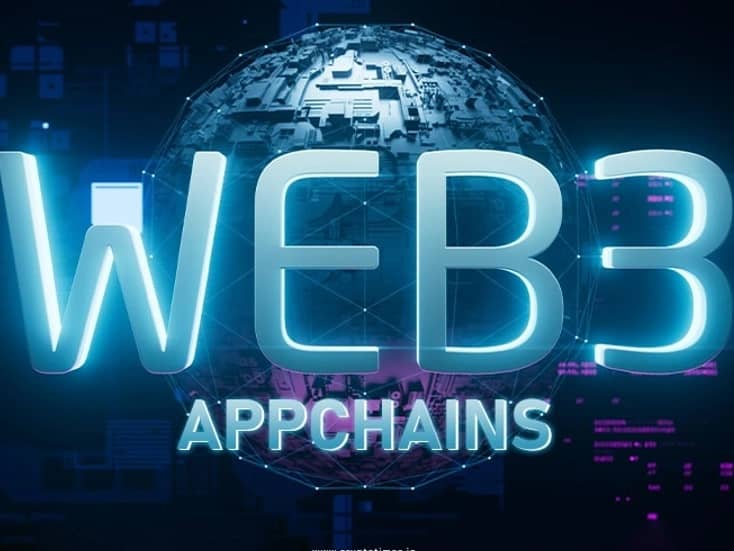订阅 wiki
Share wiki
Bookmark
Appchain
Appchain
应用链是一种区块链,旨在运行单个应用程序以实现特定功能。这种方法允许交易处理、费用、智能合约功能以及许多其他因素,这些因素都是根据特定应用程序的需求量身定制的。与以太坊等通用区块链相比,这种定制可以提高效率、可扩展性和安全性。[1][2][6][7][11][12]
概述
Appchains是专门设计的解决方案,旨在满足去中心化应用程序或web3协议的独特任务需求。Appchains是web3中一个相对较新的概念,旨在增强区块链应用程序的可扩展性、互操作性和模块化。与通用链不同,appchains专门围绕某些用例。专业化通常会带来更可靠的费用、更高的性能、定制的用户/开发者体验以及更高的应用程序代币价值捕获。[1][4][5]
Appchains被认为是自主的,因为共识层和应用层的治理紧密相连。因此,appchains可以通过硬分叉底层链来从应用层的实现错误中恢复。自主性还可以保护应用程序免受平台风险的影响。另一方面,appchains对社会协调提出了更高的要求。在appchain上部署新的dapps或在appchains之间建立安全的跨链桥通常需要各自社区的参与。跨链可组合性也比通用链上智能合约之间的可组合性复杂得多。[4]
Appchains vs. 传统区块链
Appchains 可以是 Layer 1、Layer 2、Layer 3 和 侧链 的形式。它们的区别在于它们专注于特定任务,以及如何围绕这些任务进行高效构建。[5]
Layer 1 区块链是主要的区块链,如 以太坊 或 Avalanche,多个 web3 应用程序在这些区块链上运行。Appchains 在现有的 Layer 1 区块链之上运行,以利用其安全性和 gas 费用,但改进了现有的 Layer 1 区块链结构,从而为开发者提供更大的自由度。[1]
Layer 2 区块链 (L2s) 是 Layer 1 区块链(如以太坊)的扩展解决方案,其中一个单独的区块链完成主区块链的一些任务。L2s 可以同时为许多不同的应用程序运行,并且是它们运行的 L1 区块链的通用扩展解决方案,而 appchains 是特定于应用程序的。[1]
将 appchains 与传统区块链进行比较,突出了以下一些关键区别,这些区别展示了 appchains 的优势和独特功能。[3]
| 关键区别 | Apphcains | 传统区块链 |
|---|---|---|
| 目的和专业化 | 专为特定的 DApps 或相关 DApps 组构建,提供高度的专业化和定制化。 | 通用网络,旨在支持广泛的应用程序,缺乏相同的专业化水平。 |
| 共识机制 | 可以选择针对其特定需求量身定制的 共识机制,从而优化速度、安全性或其他属性。 | 通常在整个网络中使用单一的共识机制,这可能并非对每个 DApp 都是理想的。 |
| 资源管理 | 管理自己的资源,包括网络带宽、存储和计算能力,从而防止资源争用。 | 在所有 DApps 之间共享资源,在高需求期间可能会导致拥塞和性能问题。 |
| 定制化 | 提供高度的定制化,允许 DApp 开发者定义代币标准、共识规则、治理结构等。 | 具有适用于所有应用程序的标准化规则和协议,从而限制了定制选项。 |
| 安全性 | 继承主区块链的安全功能,并且可以实施针对其 DApp 需求量身定制的额外安全措施。 | 提供基线级别的安全性,但可能未针对各个 DApp 的特定安全要求进行优化。 |
| 去中心化 | 可以根据 DApp 的目标调整其去中心化程度,从而提供灵活性。 | 通常旨在在整个网络中实现一致的去中心化程度。[3] |
应用链 vs 单片链
单片链是集所有功能于一体的解决方案,包括应用程序在内的所有功能都在基础层执行。单片链的例子包括比特币和以太坊 1.0。[7][9]
这类链有几个优点:
- 简单性:单片链不依赖外部方或协议来运行,从而降低了网络复杂性。
- 安全性:由于攻击面较小,单片链通常提供更高的安全性。
- 去中心化和不变性:所有节点都遵循相同的规则并验证相同的交易,从而确保高度的去中心化。
然而,单片链也存在明显的缺点:
- 可扩展性:有限的资源和带宽限制了交易数量和数据存储,导致网络拥塞和高费用。
- 灵活性和创新:在不影响或依赖现有应用程序的情况下升级或定制平台可能很困难。
Appchains vs Modular Chains
模块化链将其核心功能拆分为独立的层或组件,包括共识、执行、数据可用性和结算。模块化链的例子包括以太坊 2.0 和 Solana。这些链具有以下几个优点:[7]
- 可扩展性:模块化链可以通过使用并行化和专业化技术来处理更多的交易和存储更多的数据。
- 资源优化:通过将一些任务外包给其他层或链,模块化链可以优化其资源和带宽。
然而,模块化链也面临一些缺点:
- 复杂性:模块化链依赖于外部方或协议来运行,这增加了网络复杂性。
- 安全性:攻击面增加以及对外部方的依赖可能会带来安全问题。
- 去中心化权衡:不同的层或链可能具有不同的信任和验证级别,从而影响整体去中心化。
Appchains vs Layer 2 Chains
Layer 2 链是在 Layer-1 区块链之上运行的扩展解决方案,处理网络的部分或全部执行和结算功能。Layer 2 的例子包括 Optimism 和 Arbitrum。Layer 2 链具有许多优点:[7][9]
- 速度:压缩和聚合技术允许 Layer 2 处理更多交易并收取更低的费用。
- 更快的最终性:Layer 2 可以通过使用乐观或零知识证明来提供更快的最终性和确认时间。
但是,Layer 2 也存在一些局限性:
- 依赖性:Layer 2 依赖于 Layer-1 区块链来实现共识和数据可用性,这可能会限制它们的自主性和主权。
- 安全风险:由于 Layer 2 依赖于 Layer 1 区块链,因此存在恶意行为者进行欺诈或审查的风险。
Appchains vs Sidechains
侧链是与另一条区块链兼容的区块链。它们在自己的链上处理所有核心功能,但不使用其他区块链的安全性或可扩展性。侧链的例子包括Polygon。侧链具有以下几个优点:[7][9]
- 性能:侧链可以通过使用自己的资源和带宽来处理更多的交易和存储更多的数据。
- 灵活性:侧链可以根据自己的需求和偏好自定义其参数和功能。
然而,侧链也面临一些挑战:
- 安全性:不依赖于其他区块链的安全性或可扩展性,使侧链更容易受到攻击和漏洞的影响。
- 互操作性:侧链在与其他区块链通信和交换价值方面可能面临困难,因为它们需要桥梁或适配器来实现跨链交易。
技术
Appchains的工作原理是使用L1区块链作为锚定或安全层,并在其上构建一个独立的链,从而更高效、更低成本地处理交易。它可以被设计为提供诸如更快的确认时间、更低的交易费用或专门的智能合约功能等特性。
Appchains通常使用各种技术来确保其安全性,尽管它们是建立在L1区块链之上的。例如,它们可能使用侧链、Plasma链或类似技术来实现快速、安全和低成本的交易。它们也可能使用各种共识机制,例如工作量证明(PoW)、权益证明(PoS)或拜占庭容错,以确保交易得到正确验证和记录。例如,用于金融应用程序的appchain可能会选择与为供应链管理设计的appchain不同的共识机制。
总的来说,appchains提供了一种强大的方式来扩展区块链技术,并实现新的用例和应用程序,同时保持底层L1区块链的安全性和去中心化。
每个appchain将其资源专门用于特定任务,确保它们不会被用于不相关的应用程序。此外,appchain上的智能合约可以专门设计来满足各个应用程序的需求。这允许更复杂的合约逻辑,从而增强各个应用程序的功能和效率。[1][2]
通常,完整的appchain架构由五个层组成:
- 网络层: 这一层管理点对点网络功能。它使区块链中的节点能够通信、交换数据并参与交易验证过程。
- 应用层: 这一层托管在区块链上运行的应用程序。它提供开发人员可以用来构建、部署和管理去中心化应用程序(DApps)的操作的接口。
- 数据层: 数据层负责组织和存储区块链信息。这包括维护区块链的状态、记录交易细节以及处理智能合约数据。
- 共识层: 这一层实现appchain的共识算法。它可以包含各种共识算法,例如工作量证明(PoW)或权益证明(PoS)。
- 智能合约层: 这一层促进智能合约的自动化、验证和执行。
Appchains 的优势
可扩展性
Appchains分配资源以专注于特定任务或功能。这种专业化可以提高单个应用程序的交易吞吐量并减少延迟。这有助于解决通用区块链的可扩展性挑战。[2][7]
模块化
Appchains 的特点是其模块化架构,这与通常采用单片设计的通用区块链不同。模块化结构使开发人员可以灵活地根据各个 DApp 的特定需求定制区块链的功能。[2]
互操作性
应用链被设计为支持互操作性,促进不同DApp之间的通信。这使得一个应用程序的用户可以轻松访问另一个应用程序的优势。[2][7]
定制化
在应用链系统中,开发者可以自由选择共识机制、治理结构和经济模型。这使得开发者在设计应用程序时拥有更大的自由度和创造力。[7]
创新
开发者可以自由尝试新的经济和治理模式,而不会对主链产生不利影响。这为开发创造了更具活力和协作性的环境。[7]
流行的应用链生态系统
Polkadot 平行链
Polkadot 是一个多链平台,它实现了不同区块链网络之间的互操作性。其独特的架构允许多个专门的区块链(或平行链)并行运行并交换信息。[8][11]
Litentry
Litentry 是一个去中心化的身份聚合器,允许用户跨不同的区块链和平台链接他们的身份。它是一个构建在 Polkadot 上,使用 Substrate 和 Parachain 的应用程序链。Litentry 有自己的原生代币 (LIT) 和治理模型,并利用中继链的安全性与互操作性。它为用户和开发者提供了一个保护隐私和跨链的身份验证和声誉管理平台。 [7]
Acala
Acala 是一个去中心化金融中心,提供多抵押稳定币、无需信任的质押衍生品和一个去中心化交易所平台。它是一个使用 Substrate 和平行链构建在 Polkadot 上的应用链。它有自己的原生代币 (ACA) 和治理模型,并利用中继链的安全性和互操作性。Acala 为用户和开发者提供了一个快速且低成本的 Web3 金融应用和资产平台。 [7]
Cosmos Zones
Cosmos 是一个去中心化的独立区块链网络,可以相互通信和交换数据。Cosmos 使用轮辐模型,其中每个 Cosmos“区域”都连接到 Cosmos Hub,Cosmos Hub 是网络的中心。[8]
Osmosis
Osmosis 是一个去中心化交易所平台,允许用户在 Cosmos 网络的不同区域创建和交易自定义流动性池。它是一个基于 Cosmos 构建的应用链,使用 Cosmos SDK 和 Tendermint。它有自己的原生代币(OSMO)和治理模型,并利用 Cosmos Hub 的安全性和互操作性。Osmosis 为用户和开发者提供了一个高性能和可定制的平台,用于自动化做市和流动性提供。
Avalanche 子网
Avalanche 子网是在 Avalanche 网络中创建的独立区块链。这些子网可以定制以满足不同去中心化应用程序 (dApps)的特定需求,并且可以使用 Avalanche 共识机制无缝地相互交互。[8][11]
SKALE
SKALE 是一个去中心化网络,它为创建和运行高性能、可定制的应用程序链提供了一个平台。它旨在实现可扩展、安全和易于使用,使其成为希望快速高效地构建去中心化应用程序的开发人员的热门选择。SKALE 的独特功能之一是它使用“弹性侧链”,可以动态调整大小以满足不断变化的需求。这使得开发人员可以扩展他们的应用程序,而无需担心性能问题或高交易费用。
Polygon Supernets
Polygon Supernets 是构建在 Polygon 网络之上的应用链生态系统,该网络使用 Ethereum 作为其底层区块链。开发者可以使用区块链构建平台 Polygon Edge 创建他们自己的、与 EVM 兼容的应用程序链,并具有可定制的功能。这些应用程序链可以使用 MATIC 代币进行质押,并在 Proof-of-Stake 或权威证明模型下运行。每个 Supernet 都由一组 validator 节点提供服务,以确保安全性和稳定性。
dYdX
dYdX 是一个去中心化的保证金交易平台,允许用户进行永续合约和现货市场的杠杆交易。它是一个建立在 Ethereum 上的应用链,使用 StarkWare 的 zero-knowledge rollup 技术。它有自己的原生代币 (DYDX) 和治理模型,并利用以太坊的安全性和数据可用性。dYdX 为用户和开发者提供了一个快速且低成本的平台,用于高级交易功能和衍生品。[7][11]
发现错误了吗?
